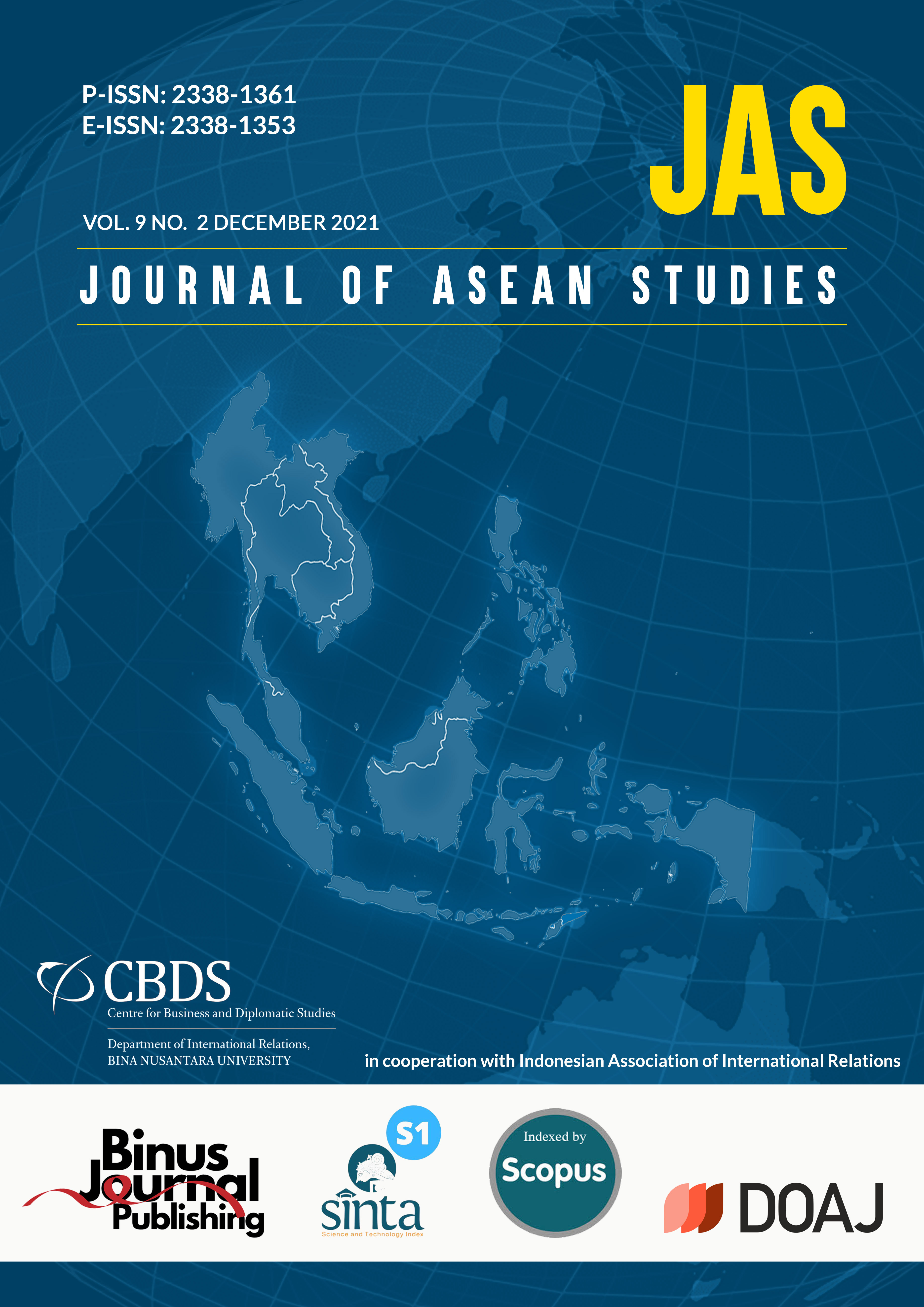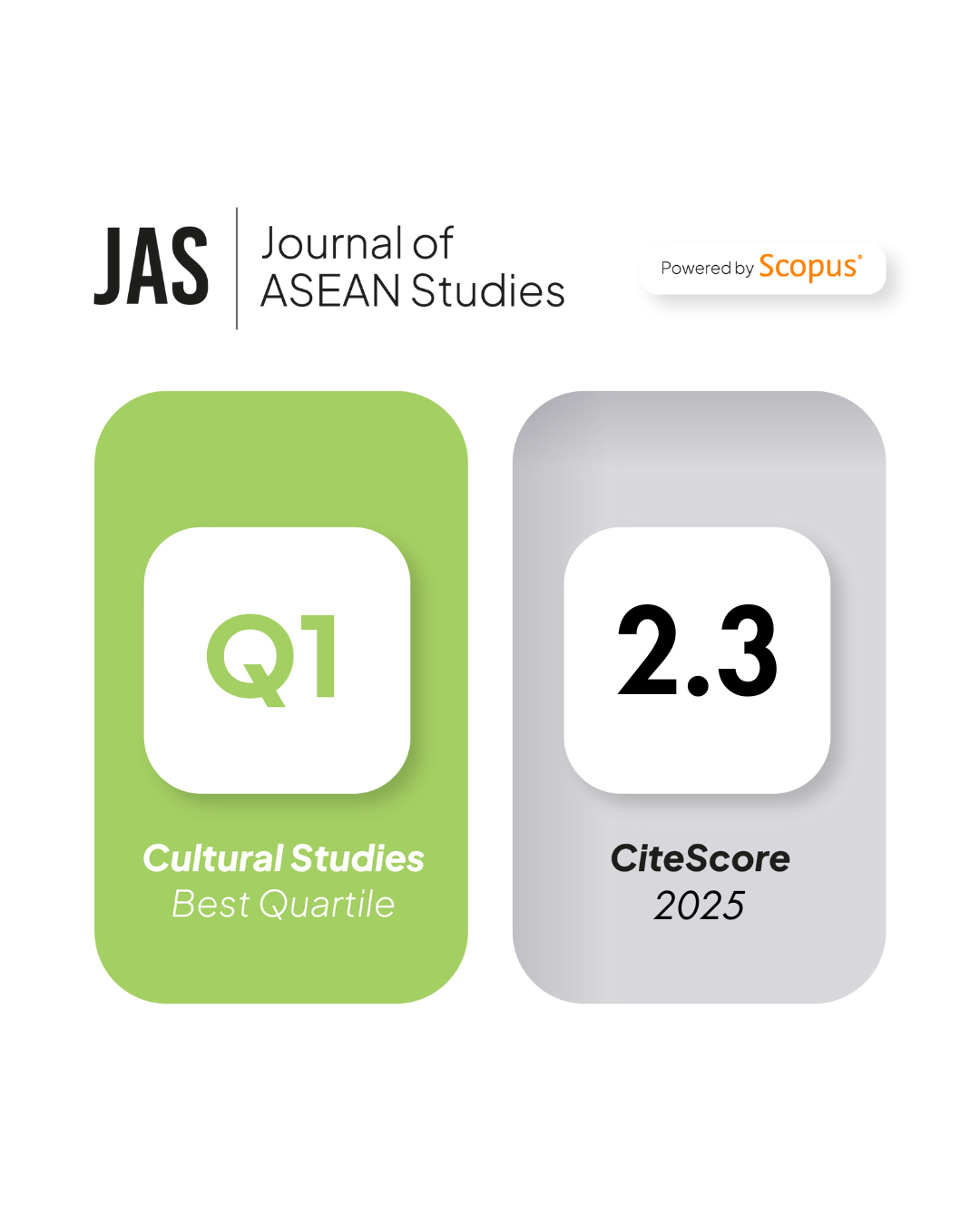THE EFFECTS OF INTEREST RATE ON REAL EFFECTIVE EXCHANGE RATE VOLATILITY SPILLOVER IN MALAYSIA AND THAILAND: EMPIRICAL EVIDENCE
DOI:
https://doi.org/10.21512/jas.v9i2.7517Keywords:
asymmetric analysis, interest rate, nonlinear causality, real effective exchange rateAbstract
The research examined this asymmetric effect between the interrelationship of the interbank rate on the external competitiveness purchasing power represented by the real effective exchange rate for Malaysia and Thailand using monthly data covering the period of 1994 until 2020. The empirical findings confirms an asymmetric effect between interbank rate and real effective exchange rate based on the nonlinear autoregressive distributed lag estimates. The research also finds a unidirectional asymmetric causal relationship running from real effective exchange rate on interbank rate Thailand, which indicate the monetary policy has a direct relationship on interbank rate volatility. While in Malaysia, there is no causality running between both variables since the country has proposed several soft monetary policies and more concentrating on the short-term borrowing by improving the tight money supply circulation based on the domestic inflation, global economic, and financial market volatility. Therefore, the research recommends a specific need of monetary stabilizer policy to stabilize both countries’ currencies and put more effort to liberalize the foreign exchange rate system in a globalized economy.
References
Abdoh, M. M. Y., Yusof, M. N. H., Zulkifli, M. S. A, Bulot, N., & Ibrahim, N. J. (2016). Macroeconomic factors that influence exchange rate fluctuation in ASEAN countries. International Academic Research Journal of Social Science, 2(1), 89-94.
AbuDalu, A. & Ahmed, E. M. (2014). The determinants of ASEAN-5 real effective exchange rate vis-ávis the UK pound. World Journal of Entrepreneurship, Management and Sustainable Development, 10(2), 98-118.
Adler, K. & Grisse, C. (2014). Real exchange rates and fundamentals: Robustness across alternative model specifications. SNB Working Papers 7/2014.
Ahmed, H. F. T. & Mazlan, N. S. (2021). The impact of interest rate on exchange rate within ASEAN countries: Evidence from linear and nonlinear framewirks. Global Journal of Emerging Market Economies, 13(1), 7-34. https://doi.org/10.1177%2F0974910120974798
Aizenman, J., Chinn, M. D., & Ito, H. (2016). Monetary policy spillovers and the trilemma in the new normal: Periphery country sensitivity to core country conditions. Journal of International Money and Finance, 68, 298-330. https://doi.org/10.1016/j.jimonfin.2016.02.008
Aizeman, J., Hutchison, M., & Noy, I. (2011). Inflation targeting and real exchange rates in Emerging markets. World Development, 39(5), 712-724.
Alsamara, M., & Mrabet, Z. (2019). Asymmetric impacts of foreign exchange rate on the demand for money in Turkey: New evidence from nonlinear ARDL. International Economics and Economic Policy, 16(2), 335-356. https://doi.org/10.1007/s10368-018-0421-y
Andonov, A., Bauer, R. M., & Cremers, K. M. (2017). Pension fund asset allocation and liability discount rates. Review of Financial Studies, 30(8), 2555-2595. https://dx.doi.org/10.2139/ssrn.2070054
Andries¸, A. M., Capraru, B., Ihnatov, I., & Tiwari, A. K. (2017). The relationship between exchange rates and interest rates in a small open emerging economy: The case of Romania. Economic Modelling, 67, 261-274. https://doi.org/10.1016/j.econmod.2016.12.025
Ariff, M. & Yap, Meow-Chung, M. (2001) Financial crisis in Malaysia. In T.-S. Yu and D. Xu (Eds.), East Asia Rising Again. Singapore: World Scientific Publishing.
Bagchi, D., Chortareas, G. E., & Miller, S. M. (2004). The real exchange rate in small, open developed economies: Evidence from cointegration analysis. Economic Record, 80(248), 76-88. https://doi.org/10.1111/j.1475-4932.2004.00126.x
Balduzzi, P. & Chiang, I. E. (2020). Real exchange rate and currency risk premiums. The Review of Asset Pricing Studies, 10(1), 94-121.
Bank of Thailand (2020). Development of monetary policy framework in Thailand. https://www.bot.or.th/English/MonetaryPolicy/MonetPolicyKnowledge/Pages/Framework.aspx
Bank of Thailand. (2021). Interest rates. https://www.bot.or.th/english/statistics/_layouts/application/interest_rate/in_rate.aspx
Barbosa, L. O. S., Jayme, F. G. Jr., & Missio, F. J. (2018). Determinants of the real exchange rate in the long-run for developing and emerging countries: A theoretical and empirical approach. International Review of Applied Economics, 32(1), 62-83. https://doi.org/10.1080/02692171.2017.1332017
Bartolli, L. (1995). Purchasing power parity measures of competitiveness. Finance and Department, 32(3), 46-49. https://doi.org/10.5089/9781451952193.022
Bowe, M., & Saltvedt, T. M. (2004). Currency invoicing practices, exchange rate volatility and pricing to market: Evidence from product level data. International Business Review, 13(3), 281-308. https://doi.org/10.1016/j.ibusrev.2004.01.003
Brailsford, T., Penm, J. H. W., & Lai, C. D. (2006). Effectiveness of high interest rate policy on exchange rates: A reexamination of the Asian financial crisis. Advances in Decision Sciences, 4, 1-9. https://doi.org/10.1155/JAMDS/2006/35752
Capasso, S., Napolitano, O., & Jiménez, V. A. L. (2019). The long run interrelationship between exchange rate and interest rate; the case of Mexico. Journal of Economic Studies, 46(7), 1380-1397. https://doi.org/10.1108/JES-04-2019-0176
Cecchetti, S. G., Grifoli, T. M., Narita, M., & Sahay, R. (2020). US or domestic monetary policy: Which matters more for financial and stability? IMF Economic Review, 68, 35-65. https://doi.org/10.1057/s41308-020-00108-2
Central Bank of Malaysia. (2021). Interest rates and volumes. https://www.bnm.gov.my/interest-rates-volumes
Cheong, L. M. (2005). Globalization and the operation of monetary policy in Malaysia. BIS Papers, 23, 209-215.
Chowdhury, K. (2012). Modelling the dynamics, structural breaks and the determinants of the real exchange rate of Australia. International Financial, Markets, Institution and Money, 22(2), 343-358. http://dx.doi.org/10.1016/j.intfin.2011.10.004
Cobham, D. (2021). A comprehensive classification of monetary policy frameworks in advanced and emerging economies. Oxford Economic Papers, 73(1), 2-26. https://doi.org/10.1093/oep/gpz056
Curran, M., & Velic, A. (2019). Real exchange rate persistence and country characteristics: A global analysis. Journal of International Money and Finance, 97, 35-56. https://doi.org/10.1016/j.jimonfin.2019.06.001
Data and analytics. (2021). J. P. Morgan. https://www.jpmorgan.com/solutions/cib/securities-services/data-analytics
Dickey, D. A., & Fuller, W. A. (1981). Likelihood ratio statistics for autoregressive time series with a unit root. Econometrica, 49(4), 1057–1072. https://doi.org/10.2307/1912517
Draz, M., Ahmad, F., Gupta, B., & Amin, W. (2019). Macroeconomic fundamentals and exchange rates in South Asian economies. Journal of Chinese Economic and Foreign Trade Studies, 12(2), 104-119. https://doi.org/10.1108/JCEFTS-01-2019-0007
Enders, W., & Lee, J. (2012). The flexible fourier form and Dickey-Fuller type unit root tests. Economics Letters, 117(1), 196–199. https://doi.org/10.1016/j.econlet.2012.04.081
Engel, C. (2019). Real exchange rate convergence: The roles of price stickiness and monetary policy. Journal of Monetary Economics, 103, 21-32. https://doi.org/10.1016/j.jmoneco.2018.08.007
Furman, J., Stiglitz, J. E., Bosworth, B. P., & Radele, S. (1998). Economic crises: Evidence and insights from East Asia. Brookings Papers on Economic Activity, 2, 1-135.
Golit, P., Salisu, A., Akintola, A., Nsonwu, F., & Umoren, I. (2019). Exchange rate and interest rate differential in G7 Economies. Bulletin of Monetary Economics and Banking, 22(3), 263-286. http://dx.doi.org/10.21098/bemp.v22i3.1147
Gozgor, G. (2014). Causal relation between economic growth and domestic credit in the economic globalization: Evidence from the Hatemi-J’s test. The Journal of International Trade & Economic Development, 24(3), 395-408. https://doi.org/10.1080/09638199.2014.908325
Granville, B., & Mallick, S. (2010). Monetary policy in Russia: Identifying exchange rate shocks. Economic Modelling, 27(1), 432-444. https://doi.org/10.1016/j.econmod.2009.10.010
Hanson, S. G. & Stein J. C. (2015). Monetary policy and long-term real rates. Journal of Financial Economics, 115, 429-448. http://dx.doi.org/10.1016/j.jfineco.2014.11.001
Hatemi-J, A. (2012). Asymmetric causality tests with an application. Empirical Economic, 43, 447-456. https://doi.org/10.1007/s00181-011-0484-x
Hnatkovska, V., Lahiri, A., & Vegh, C. A. (2013). Interest rate and the exchange rate: A non-monotonic tale. European Economic Review, 63, 68-93. https://doi.org/10.1016/j.euroecorev.2013.06.001
Hoang, V., Nguyen, D. K., & Pham, T. A. (2020). On the effects of monetary policy in Vietnam: Evidence from a trilemma analysis. The World Economy, 1-34. https://doi.org/10.1111/twec.13025
Hossain, A. A. (2017). Monetary policy for maintaining low, stable inflation in Malaysia. The Journal of Developing Areas, 51(2), 381-404. https://doi.org/10.1353/jda.2017.0052
Kalemli-Ozcan, S. & Varela, L. (2019). Exchange Rate and Interest Rate Disconnect: The Role of Capital Flows, Currency Risk and Default Risk. Meeting Papers 351, Society for Economics Dynamics
Karamelikli, H. & Karimi, M. S. (2020). Asymmetric relationship between interest rates and exchange rate: Evidence from Turkey. International Journal of Finance and Economics, 1-11. https://doi.org/10.1002/ijfe.2213
Katrakilidis, C. & Trachanas, E. (2012). What drives housing price dynamics in Greece: New evidence from asymmetric ARDL cointegration. Economic Modelling, 29(4), 1064-1069. https://doi.org/10.1016/j.econmod.2012.03.029
Kayhan, S., Bayat, T., & Ugur, A. (2013). Interest rates and exchange rate relationship in BRIC-T countries. Ege Academic Review, 13(2), 227-236.
Khin, A. A., Yee, C. Y., Seng, L. S., Wan, C. M., & Xian, G. Q. (2017). Exchange rate volatility on macroeconomic determinants in Malaysia: Vector error correction method (VECM) model. Journal of Global Business and Social Entrepreneurship, 3(5), 36-45.
Kia, A. (2013). Determinants of the real exchange rate in a small open economy: Evidence from Canada. Journal of International Financial Markets, Institutions and Money, 23, 163-178. https://doi.org/10.1016/j.intfin.2012.09.001
Kwiatkowski, D., Phillips, P. C. B., Schmidt, P., & Shin, Y. (1992). Testing the null hypothesis of stationarity against the alternative of a unit root. Journal of Econometrics, 54(1-3), 159-178. https://doi.org/10.1016/0304-4076(92)90104-Y
McCauley, R. N. (2006). Understanding monetary policy in Malaysia and Thailand: Objectives, instruments and independence. BIS Papers chapters. In Bank for International Settlements (Ed.), Monetary Policy in Asia: Approaches and Implementation, 31, 172-196.
Nguyen, D.K., Sousa, R.M., & Uddin, G.S. (2015). Testing for asymmetric causality between U.S. equity returns and commodity futures returns. Finance Research Letters, 12, 38-47. https://doi.org/10.1016/j.frl.2014.12.002
Nguyen, N., Harvie, C., & Suardi, S. (2020). ASEAN income gap and the optimal exchange rate regime. Applied Economics, 52(3), 1-17. https://doi.org/10.1080/00036846.2019.1645278
Oliver, V. (1997). Early beginnings of the beginning of the quantity theory of money and their context in Polish and Prussian monetary policies. Economic History Reviews, 50(3), 430-449. https://doi.org/10.1111/1468-0289.00063
Patel, D. & Mah, G. (2018). Relationship between real exchange rate and economic growth: the case of South Africa. Journal of Economics and Behavioral Studies, 10(1), 146-158. https://doi.org/10.22610/jebs.v10i1(J).2098
Pattanaik, S. & Mitra, K. A. (2001). Interest rate defense of exchange rate: Tale of the Indian rupee. Economic and Political Weekly, 36, (46/47), 4418-4427.
Perron, P. (1989). The great crash, the oil price shock, and the unit root hypothesis. Econometrica, 57, 1361-1401. https://doi.org/10.2307/1913712
Pesaran, M. H., Shin, Y., & Smith, R. J. (2001). Bounds testing approaches to the analysis of level relationships. Journal of Applied Econometrics, 16, 289-326. https://doi.org/10.1002/jae.616
Phuc, N. V., & Duc, V. H. (2019). Macroeconomics determinants of exchange rate pass-through: New evidence from the Asia-Pacific region. Emerging Markets Finance and Trade, 1-16. https://doi.org/10.1080/1540496X.2018.1534682
Saraç, T. B. & Karagöz, K. (2016). Impact of short-term interest rate on exchange rate: The case of Turkey. Procedia Economics and Finance, 38, 195-202. https://doi.org/10.1016/S2212-5671(16)30190-3
Shin, Y., Yu, B., & Greenwood-Nimmo, M. (2014). Modelling Asymmetric Cointegration and Dynamic Multipliers in a Nonlinear ARDL Framework. In W. Horrace, & R. Sickles (Eds.), The Festschrift in Honor of Peter Schmidt: Econometric Methods and Applications (pp. 281-314). Springer.
Sun, W. & De, K. (2019). Real exchange rate, monetary policy, and the U.S. economy: Evidence from a FAVAR model. Economic Inquiry, 57(1), 552-568. https://doi.org/10.1111/ecin.12723
Tari, R. & Abasiz, T. (2009). Frequency domain approach and short-run and long run causality test: Evidence from Turkey for interest rate and exchange rate relationship. METU Studies in Development, 36(2), 405-421.
Timeline: Thailand’s turbulent politics over two decades. (2019, March 22). Reuters. https://www.reuters.com/article/us-thailand-election-timeline-idUSKCN1R30HR
Verico, K. (2017). The key factors of economic integration in Southeast Asia: Case of Indonesia, Malaysia and Thailand. Journal of ASEAN Studies, 4(2), 107-126.
Yakubu, Z., Loganathan, N., Sethi, N., & Golam Hassan, A. A. (2021). Do financial development, trade openness and political stability complement for Egypt’s economic growth? Journal of International Commerce, Economics and Policy, 12(1). https://doi.org/10.1142/S1793993321500010
World Bank. (2021). World Development Indicators. Retrieved from http: www.worldbank.org.
Malaysia: December 2001. (2001, December 05). World Trade Organization. https://www.wto.org/english/tratop_e/tpr_e/tp180_e.htm
Wu, J. L. & Chen, S. L. (1998). A re-examination of real interest rate parity. The Canadian Journal of Economics, 837-851.
Downloads
Published
How to Cite
Issue
Section
License
Copyright (c) 2021 Mohd Jaffri Abu Bakar, Nanthakumar Loganathan, Asan Ali Golam Hassan, Tirta Nugraha Mursitama

This work is licensed under a Creative Commons Attribution-NonCommercial 4.0 International License.






















